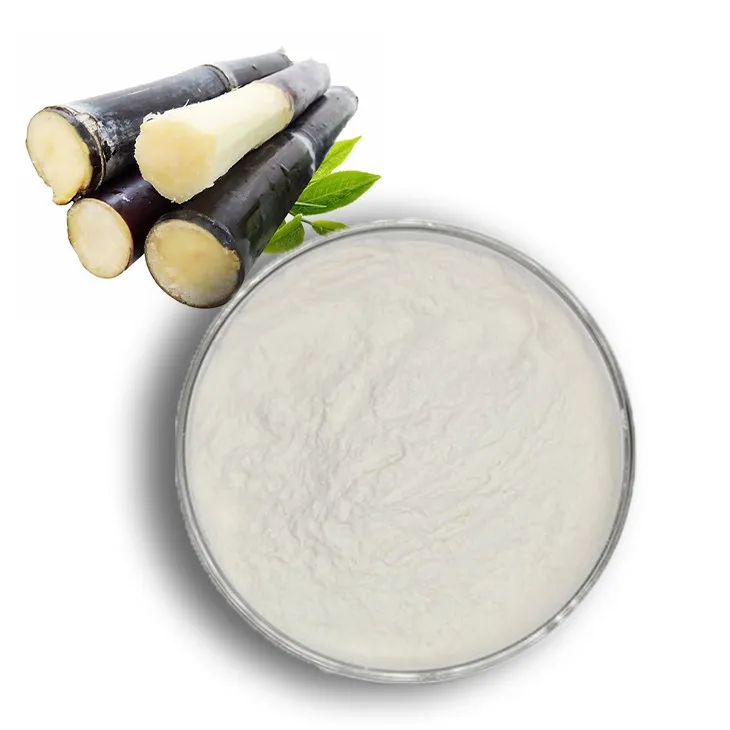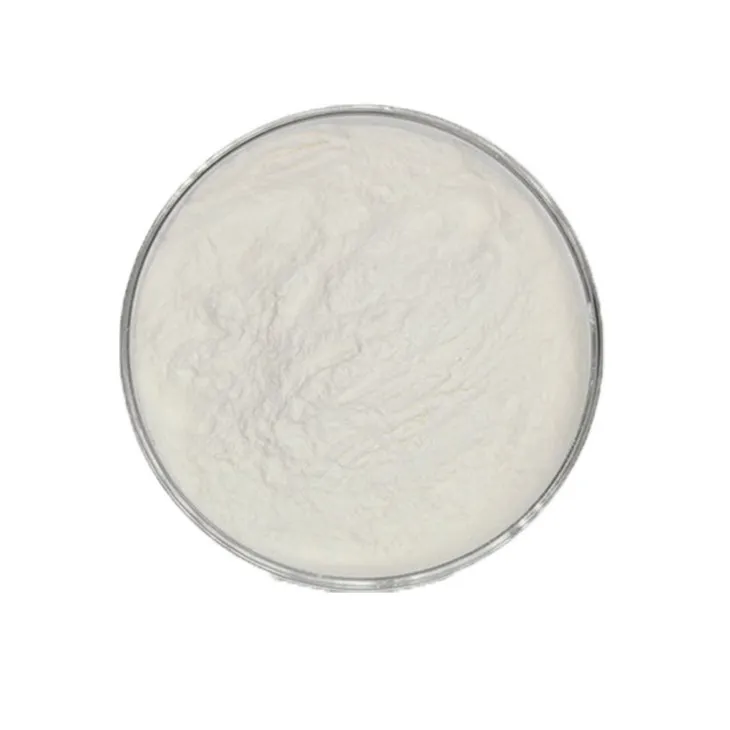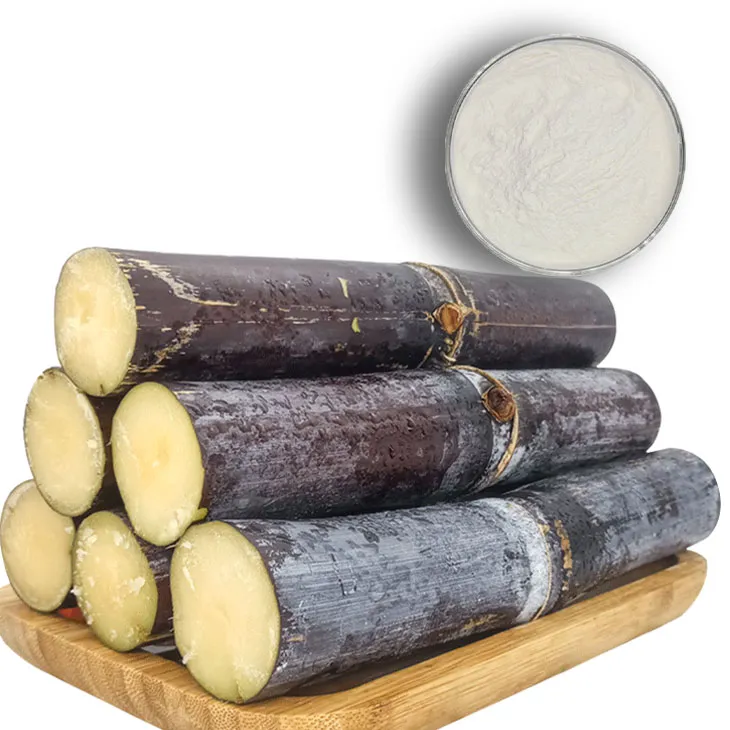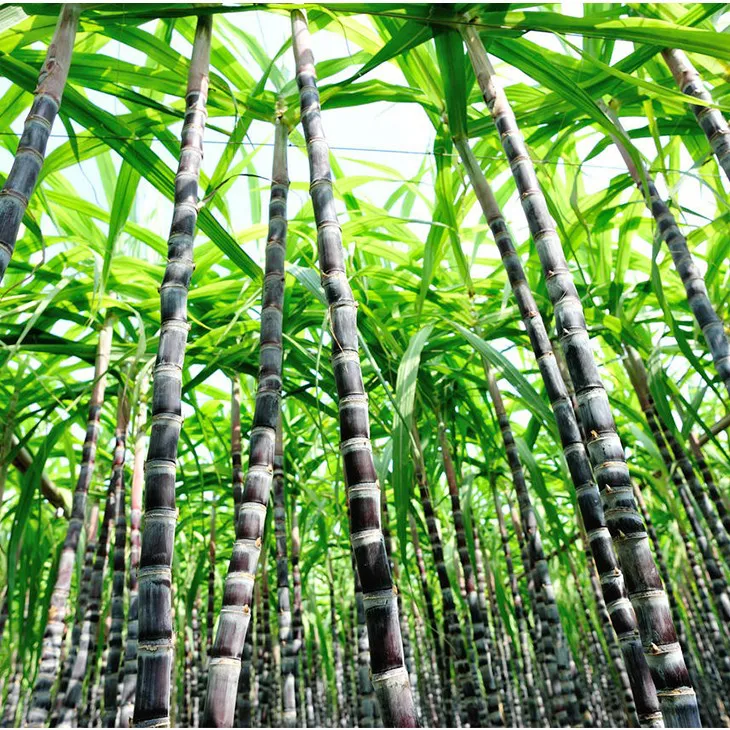- 0086-571-85302990
- sales@greenskybio.com
The process of extracting sugarcane wax from sugarcane extracts.
2024-11-28

1. Introduction
Sugarcane is a widely cultivated plant known for its use in sugar production. However, it also contains sugarcane wax, which has a variety of potential applications in different industries. The extraction of sugarcane wax from Sugarcane Extracts is an important process that has been studied and refined over time. This article will delve into the details of this extraction process, from obtaining the initial Sugarcane Extract to the final purification of the cane wax.

2. Obtaining Sugarcane Extract
2.1 Mechanical Means
One way to obtain sugarcane extract is through mechanical means. This involves crushing the sugarcane stalks to release the juice. The sugarcane stalks are first cut and then passed through rollers. These rollers apply pressure to squeeze out the juice, which contains not only sugars but also other substances including the precursor to sugarcane wax. This mechanical extraction method is relatively simple and has been used for a long time in the sugar industry. However, it may not extract all the valuable components efficiently, and some impurities may also be present in the resulting extract.2.2 Chemical Means
Chemical methods can also be used to obtain sugarcane extract. In some cases, chemicals are added to break down the cell walls of the sugarcane more effectively, allowing for a more complete extraction of the components. For example, enzymes can be used to hydrolyze the polysaccharides in the cell walls, making it easier to release the juice. Chemical extraction methods need to be carefully controlled to avoid introducing unwanted chemicals into the extract. Moreover, the cost of using chemicals and the subsequent removal of these chemicals from the extract need to be considered.
3. Separation of Cane Wax from the Extract
3.1 Solvent Extraction
Solvent extraction is a fundamental step in separating cane wax from the sugarcane extract. Different solvents are used based on their ability to dissolve cane wax while leaving other substances relatively insoluble. For example, hexane is a commonly used solvent for this purpose. The principle behind solvent extraction is the differential solubility of cane wax and other substances in the extract. When the solvent is added to the extract, the cane wax dissolves in the solvent, while other substances such as sugars and proteins may remain in the aqueous phase or form a separate layer.3.2 Chromatography
In some cases, chromatography can be used as a modern separation technique. There are different types of chromatography, such as column chromatography or thin - layer chromatography, that can be applied depending on the scale and requirements of the separation. Chromatography works by separating the components of a mixture based on their different affinities for a stationary phase and a mobile phase. For cane wax extraction, it can help in further purifying the cane wax - containing fraction obtained from solvent extraction. For example, in column chromatography, the extract is passed through a column filled with a stationary phase material, and the different components are eluted at different times depending on their interactions with the stationary and mobile phases.
4. Purification of Cane Wax
4.1 Crystallization
After the extraction of cane wax from the sugarcane extract, purification is necessary to eliminate any remaining contaminants. Crystallization is one of the important purification processes. The cane wax - solvent solution is cooled or concentrated in a controlled manner. As the solubility of the cane wax decreases, it starts to form crystals. The crystals are then separated from the remaining liquid, which may contain impurities. The process of crystallization can be repeated multiple times to improve the purity of the cane wax.4.2 Recrystallization
Recrystallization is a more refined form of crystallization. The crystals obtained from the initial crystallization process are dissolved again in a suitable solvent, and the process of crystallization is repeated. This helps in removing any remaining impurities that may have been trapped within the crystals during the first crystallization. Recrystallization can significantly improve the purity of the cane wax, making it suitable for various applications.
5. Applications of Cane Wax
5.1 In the Food Industry
Cane wax obtained through this extraction and purification process has potential uses in the food industry. It can be used to enhance the texture of food products. For example, it can be added to chocolates to give them a smoother and shinier appearance. It can also act as a glazing agent on fruits to prevent moisture loss and improve their shelf - life.5.2 In the Cosmetics Industry
In the cosmetics industry, cane wax can provide a protective coating. It can be used in lip balms, lotions, and creams to form a barrier on the skin, preventing moisture loss and protecting the skin from environmental factors. Additionally, it can be used to give products a certain texture and consistency, making them more appealing to consumers.5.3 In Other Industries
Cane wax also has potential applications in other industries. For example, in the pharmaceutical industry, it can be used as a coating material for tablets to control the release of the drug. In the packaging industry, it can be used as a component of coatings to improve the barrier properties of packaging materials, protecting the contents from moisture, oxygen, and other environmental factors.6. Conclusion
The process of extracting sugarcane wax from sugarcane extracts is a complex but well - studied procedure. Starting from the extraction of the sugarcane extract, through separation techniques such as solvent extraction and chromatography, and finally purification by crystallization and recrystallization, high - quality cane wax can be obtained. This cane wax has a wide range of potential applications in various industries, from food to cosmetics and beyond. As research continues, it is expected that the extraction process will be further optimized, and new applications for cane wax will be discovered.
FAQ:
What are the common methods for obtaining sugarcane extract?
There are two main methods for obtaining sugarcane extract. One is mechanical means, which might involve crushing or pressing the sugarcane plant to extract the juice. The other is chemical means, where certain chemicals can be used to break down the plant material and release the extract. However, the mechanical method is more commonly used in large - scale sugarcane processing.
Why is chromatography sometimes used in the separation step?
Chromatography is sometimes used in the separation step because it can effectively separate different compounds based on their different affinities for the stationary and mobile phases. In the case of sugarcane extract for cane wax extraction, it can help separate cane wax from other substances that have different chemical properties. This allows for a more precise separation compared to some other methods.
How does solvent extraction work in the process of cane wax extraction?
Solvent extraction in cane wax extraction works based on the differential solubility of cane wax and other substances in the extract. A suitable solvent is chosen in which cane wax has a different solubility compared to other components in the extract. When the solvent is added to the extract, cane wax will dissolve in the solvent while other substances may remain undissolved or dissolve to a different extent. Then, by separating the solvent - containing cane wax from the rest of the mixture, the cane wax can be further isolated.
What is the importance of purification in obtaining high - quality cane wax?
Purification is crucial in obtaining high - quality cane wax. The extract contains various substances, and during the extraction process, some contaminants may still be present. Purification processes such as crystallization and recrystallization are used to eliminate these remaining contaminants. By purifying the cane wax, its quality is enhanced, making it more suitable for its potential uses in different industries, such as in food and cosmetics.
What are the potential applications of cane wax in the food industry?
In the food industry, cane wax can be used to enhance the texture of food products. For example, it can be used as a coating on fruits to prevent moisture loss and spoilage, or it can be added to certain confectionery items to improve their appearance and texture. It can also act as a release agent in baking, preventing food from sticking to pans.
Related literature
- Title: Advances in Sugarcane Wax Extraction and Its Applications"
- Title: "The Chemistry and Processing of Sugarcane Wax: A Review"
- Title: "Sugarcane Wax: Properties, Extraction, and Industrial Significance"
- ▶ Hesperidin
- ▶ Citrus Bioflavonoids
- ▶ Plant Extract
- ▶ lycopene
- ▶ Diosmin
- ▶ Grape seed extract
- ▶ Sea buckthorn Juice Powder
- ▶ Fruit Juice Powder
- ▶ Hops Extract
- ▶ Artichoke Extract
- ▶ Mushroom extract
- ▶ Astaxanthin
- ▶ Green Tea Extract
- ▶ Curcumin
- ▶ Horse Chestnut Extract
- ▶ Other Product
- ▶ Boswellia Serrata Extract
- ▶ Resveratrol
- ▶ Marigold Extract
- ▶ Grape Leaf Extract
- ▶ New Product
- ▶ Aminolevulinic acid
- ▶ Cranberry Extract
- ▶ Red Yeast Rice
- ▶ Red Wine Extract
-
Sea buckthorn oil
2024-11-28
-
Alisma Extract
2024-11-28
-
Rose Hip Extract
2024-11-28
-
Europen Bilberry Extract
2024-11-28
-
Pine bark Extract Powder
2024-11-28
-
Curcumin
2024-11-28
-
Kelp Extract Powder
2024-11-28
-
Almond Extract Powder
2024-11-28
-
Tongkat Ali Extract Powder
2024-11-28
-
Resveratrol extract
2024-11-28





















